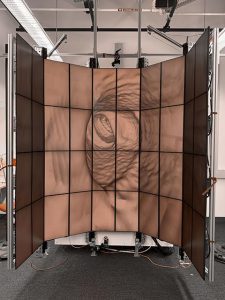Nonprofits and the car show community?
Recently, I attended the Drive for Dana car show at the Smithhaven Mall. The strength and support of the car community that comes out to support a charity is incredible. Every weekend, actually every night of the week, there are shows. On many nights there are multiple events at different spots on Long Island. They are free to attend as a spectator and at regular events free to show your car. But wait until it’s about a charity. More cars arrive, more money is raised and at the Drive for Dana event more auction items are bought.
I have been promoting the idea of a motorsports park on Long Island. Currently, I have been assisting with public relations and announcing. As we enter the fifth year of racing in Calverton it has become very clear that the car, race car, show car, high-performance street car community is very strong. Besides the generosity seen at the car shows, there is an amazing amount of driving skills shown.
It’s definitely a feel-good story when monies are raised for a charity, but that’s only a portion of the story.
Long Island’s history and development of auto racing has led to many careers. We have seen some drivers move on to the professional level. Years ago, Steve Park enjoyed racing in Nascar, and today we have Justin Ashley running a Top Fuel Dragster.
The racing we enjoy at Calverton on the 7,000-foot runway that Grumman used when they were on Long island hosting drag racing (most cars are street legal, Drifting), the cars have more safety equipment than many others and Go-karts. From the cute 5-year olds to the much older that race around the country and a few even beyond that.
Long Island at one point had multiple circle tracks (now we have one), multiple drag-racing facilities and even a road course track that held a Formula One race. Are the race tracks as strong as they once were? No. Is the car community as far reaching as it once was? From what I see at these car shows and race events, it may not be as big, but there is a huge interest. The positives are community, careers and the economic benefit.
Brian Cohen
Three Village
DA Tierney, elder parole, redemption and compassion
A few weeks ago Suffolk County District Attorney Ray Tierney released a powerful statement warning of dangers he sees lurking in the Second Look Act, Earned Time Act, and Elder Parole Act.
He said, “These measures, cloaked as compassionate reforms, prioritize criminals over the security of law-abiding New Yorkers and, in the process, once again drag grieving families and victims into a never-ending cycle of parole hearings and reconsideration of previously imposed sentences, for the sole purpose of drastically reducing sentences for violent, dangerous offenders.”
Specifically mentioning the Elder Parole Act, Tierney continued, ”This bill grants automatic parole hearings every two years to inmates who are 55 and older, and who have served 15 years in prison, regardless of the crime they were convicted of. Murderers, rapists, even cop killers would get a shot at freedom just for aging behind bars. This bill eliminates life without parole for serial and mass murderers.”
Hoping for redemption is a noble goal, but how that “hope” is viewed by loved ones grieving their murdered law enforcement family members should be taken into consideration. Over the last 8 years they’ve been forced to witness 43 convicted killers released from prison.
NYS legislators considering voting for this bill should speak to the mothers, daughters, wives, husbands or children of these fallen heroes. State pols must show proper respect and consideration for these victims.
How about offering those innocents something other than the continued heartbreaking prospect of reliving the tragic loss of loved ones every 24 months.
New York State currently has 16 members sitting on the parole board. There’s room for 3 more. Let’s offer one or more of those spots to relatives trying to overcome their tragic loss. Given that great hardship, it would seem they’ve earned a properly weighted voice in this discussion. Perhaps some of the current 16 could gain a new and better understanding of how difficult a prisoner’s release can be on those surviving their loss.
Our highly respected, local DA, Ray Tierney, looks to seek justice not vengeance for victims who’ve suffered at the hands of criminals. He is on the front lines dealing with the aftermath of some truly heinous crimes. Tierney consoles those harmed while prosecuting those charged. His warnings should not be taken lightly.
If memory serves, much of disgraced Gov. Andrew Cuomo’s (D) “criminal justice reforms” were sold on the lofty theme of redemption. If these kinds of grand ideas are going to be tried, we cannot forget those whose lives are devastated, when those grand ideas horribly fail them. At the very least, they’re innocent victims worthy of our compassion.
Jim Soviero
Setauket
In response to Drew Biondo’s letter from June 5 edition of TBR
He may call it “silly season,” but spreading misinformation, spin, and false claims isn’t silly, it’s dishonest. Port Jefferson deserves facts, not political games or distractions from real issues.
Let’s set the record straight on PASSPort, a first-of-its-kind municipal rideshare service created for Port Jefferson. Like every other municipal transit program in the country, it wasn’t meant to turn a profit. It was about accessibility, safety and smarter mobility. It worked, residents used it, and they appreciated it. On May 1, 2023, then Trustee Lauren Sheprow voted in favor of PASSPort, along with the entire Board of Trustees. She even requested a test ride and had only positive things to say. Now to attack the program she helped approve isn’t just disingenuous, it’s political.
Regarding the ballot issue, Mayor Sheprow was removed not by opponents but by the Board of Elections for failing to properly complete and file her own petitions, a basic, legal requirement every candidate must meet.
Let me be clear, neither I nor anyone from my campaign has ever created or used a fake social media profile. I’ve run this campaign the way I’ve served, openly and with integrity.
Yes, I was asked by the village to use my photography to help promote the Dickens Festival. It was discussed in public meetings, disclosed to our auditor, and unanimously approved by the board where I recused myself. The images remain village property and continue to support our most cherished community event.
While Mr. Biondo claims I’ve been “disengaged,” I’ve continued serving our community through volunteer work, civic participation and staying connected with residents. Leadership isn’t just about holding office; it’s about consistent service.
As for the Maryhaven project, our process was transparent with full disclosure and open dialogue from day 1. We held a public meeting where the developer’s request was thoroughly explained. Contrast that with what we learned from another developer, who said Mayor Sheprow promised him annexation approval a year ago, something the public didn’t hear about until March 2025, only after a resident discovered it. That’s not transparency.
What should also concern us are closed-door executive sessions used for questionable purposes.
Port Jefferson deserves true transparency and open government led by a mayor who will stand for honesty, accountability and integrity. That’s what I’ve delivered, and that’s what I’ll continue to fight for.
Kathianne Snaden
Port Jefferson
Armed guards have no place in schools
On Thursday, June 5, parents in the Three Village Central School District received what was deemed a “survey “ regarding the possibility of placing armed guards on our school campuses. My first quarrel is with the ridiculous assertion that what we received was not so much a “survey” but a very lazy two-question attempt to assuage the minority of individuals that are demanding guns at our schools. Parents were simply asked what school their child/children attend(s) and if they are in favor of armed security. This is how we’re going to decide whether our children go to school with guns in their buildings? This is the best effort our school district could make on this highly volatile and incredibly important subject?
My second dispute is one I have previously voiced, guns have NO PLACE on school grounds. Arming security guards is the hot talking point for those who ignorantly believe that this move will make one bit of difference in the extremely minimal possibility of a violent occurrence at one of our schools. The safety of our children in school is a top priority, but there is zero proof that arming security is the solution to deterring an episode of violence. There are, however, several studies proving just the opposite, that the presence of armed guards in school settings has invited and/or intensified the violence committed. I ask those who continue to advocate for this change to actually research what happened in Parkland and Uvalde, two of the most horrific school shootings our country has ever experienced and realize that no lives were saved by their armed guards. As a matter of fact, these good guys with guns literally caused more controversy and disruption.
The armed guard crusaders need a strong dose of reality. The district has already invested in a new security system in response to our unfortunate incident in October. [In October 2024, a student at Ward Melville High School brought a backpack with a weapon inside, which they took by mistake. The student’s parents were in law enforcement.] Thankfully, Long Island has been spared any instances of mass gun violence in our schools and hopefully it will remain that way. Our one scary situation was handled professionally and transparently, but this analysis via survey of the latest campaign for change is just an apathetic attempt to mitigate the loud voices of those who scream first and read never. Our new system of detection is more than sufficient for the safety of those in our buildings, students and staff. If someone truly wants to cause harm in one of our school buildings that person will most likely make something happen. Armed security guards, whether inside or outside of our schools will not hinder their actions but will add to the chaos. I certainly do not begrudge any parent the feeling of safety and security when a child is in an academic setting, but before jumping on the bandwagon I suggest that every parent take a long, hard look at past responses to incidents in our buildings and think about how they would feel if the guns we put in the schools got into the wrong hands. This is a far heftier debate than those two questions on a survey. I will never support weapons on school grounds and will continue to advocate against any and all attempts to do so.
Stefanie Werner
Setauket
The UNneighborly House
Ever since we moved to this community 55 years ago, the Setauket Neighborhood House has been a wonderful community resource. We’ve attended birthday parties, memorial services, club meetings and art shows and have always felt comfortable and safe as we met with our friends and neighbors. In view of this, I was appalled to hear that every event is now being video and audio taped by the Neighborhood House. When one has a meeting there among friends, it is assumed that it is private and not under surveillance. Women doing yoga feel comfortable among themselves but don’t want to be watched by others, and clubs may meet to discuss sensitive topics that they don’t want shared outside of their circle. There is little need for this internal surveillance to protect the house and I encourage the board to terminate the taping and to trust our neighbors who use the house to value and protect this great community resource.
I encourage others in the community to let the Setauket Neighborhood House Board know how they feel about this audio and video taping of their meetings.
Gene Sprouse
South Setauket
Correction : The article, “Rally at Harbor Road”, which appeared in the June 5th issue, incorrectly stated that Brookhaven found a title report signed by Gloria Rocchio. In fact, Brookhaven comissioned the title report. The document with Rocchio’s signature was an easement contract.
WRITE TO US … AND KEEP IT LOCAL
We welcome your letters, especially those responding to our local coverage, replying to other letter writers’ comments and speaking mainly to local themes. Letters should be no longer than 400 words and may be edited for length, libel, style, good taste and uncivil language. They will also be published on our website. We do not publish anonymous letters. Please include an address and phone number for confirmation. Email letters to: [email protected] or mail them to TBR News Media, P.O. Box 707, Setauket, NY 11733





















